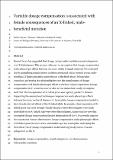Files in this item
Variable dosage compensation is associated with female consequences of an X-linked, male-beneficial mutation
Item metadata
| dc.contributor.author | Rayner, Jack Gregory | |
| dc.contributor.author | Hitchcock, Thomas | |
| dc.contributor.author | Bailey, Nathan William | |
| dc.date.accessioned | 2021-03-24T11:30:02Z | |
| dc.date.available | 2021-03-24T11:30:02Z | |
| dc.date.issued | 2021-03-31 | |
| dc.identifier | 273469240 | |
| dc.identifier | da0122f0-2209-4c3d-a1f4-746e81d34d23 | |
| dc.identifier | 85103433621 | |
| dc.identifier | 000632988100009 | |
| dc.identifier.citation | Rayner , J G , Hitchcock , T & Bailey , N W 2021 , ' Variable dosage compensation is associated with female consequences of an X-linked, male-beneficial mutation ' , Proceedings of the Royal Society of London Series B: Biological Sciences , vol. 288 , no. 1947 , 20210355 . https://doi.org/10.1098/rspb.2021.0355 | en |
| dc.identifier.issn | 0962-8452 | |
| dc.identifier.other | ORCID: /0000-0003-3531-7756/work/91341087 | |
| dc.identifier.uri | https://hdl.handle.net/10023/21697 | |
| dc.description | Funding:TJH was supported by a PhD studentship from the University of St Andrews School of Biology. The study received funding from the UK Natural Environment Research Council to NWB and JGR (NE/T0006191/1) and NWB (NE/L011255/1, NE/I027800/1). | en |
| dc.description.abstract | Recent theory has suggested that dosage compensation mediates sexual antagonism over X-linked genes. This process relies on the assumption that dosage compensation scales phenotypic effects between the sexes, which is largely untested. We evaluated this by quantifying transcriptome variation associated with a recently arisen, male-beneficial, X-linked mutation across tissues of the field cricket Teleogryllus oceanicus, and testing the relationship between the completeness of dosage compensation and female phenotypic effects at the level of gene expression. Dosage compensation in T. oceanicus was variable across tissues but usually incomplete, such that relative expression of X-linked genes was typically greater in females. Supporting the assumption that dosage compensation scales phenotypic effects between the sexes, we found tissues with incomplete dosage compensation tended to show female-skewed effects of the X-linked allele. In gonads, where expression of X-linked genes was most strongly female-biased, ovaries-limited genes were much more likely to be X-linked than were testes-limited genes, supporting the view that incomplete dosage compensation favours feminization of the X. Our results support the expectation that sex chromosome dosage compensation scales phenotypic effects of X-linked genes between sexes, substantiating a key assumption underlying the theoretical role of dosage compensation in determining the dynamics of sexual antagonism on the X. | |
| dc.format.extent | 8 | |
| dc.format.extent | 402011 | |
| dc.language.iso | eng | |
| dc.relation.ispartof | Proceedings of the Royal Society of London Series B: Biological Sciences | en |
| dc.subject | Dosage compensation | en |
| dc.subject | Sexual antagonism | en |
| dc.subject | Sex chromosomes | en |
| dc.subject | Teleogryllus oceanicus | en |
| dc.subject | QH301 Biology | en |
| dc.subject | QH426 Genetics | en |
| dc.subject | DAS | en |
| dc.subject.lcc | QH301 | en |
| dc.subject.lcc | QH426 | en |
| dc.title | Variable dosage compensation is associated with female consequences of an X-linked, male-beneficial mutation | en |
| dc.type | Journal article | en |
| dc.contributor.sponsor | NERC | en |
| dc.contributor.sponsor | NERC | en |
| dc.contributor.institution | University of St Andrews. School of Biology | en |
| dc.contributor.institution | University of St Andrews. Centre for Biological Diversity | en |
| dc.contributor.institution | University of St Andrews. St Andrews Bioinformatics Unit | en |
| dc.identifier.doi | https://doi.org/10.1098/rspb.2021.0355 | |
| dc.description.status | Peer reviewed | en |
| dc.identifier.grantnumber | NE/L011255/1 | en |
| dc.identifier.grantnumber | Ne/I027800/1 | en |
This item appears in the following Collection(s)
Items in the St Andrews Research Repository are protected by copyright, with all rights reserved, unless otherwise indicated.

